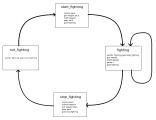An 'iact' is a type of interactive procedure that is used to make mobs perform actions. You can do some pretty complicated stuff with them, including interactive (hence the name) discussions, intelligent quest triggering, and the like. As examples, Thantos responds to Dentin's name, and the fire giants in the fire plane will give up quite a bit of history of the area if you just sit down and talk to them about it.
As common as these are, there's a lot of confusion about how iacts work. Most of this seems to stem from the fact that iacts are a form of finite state machine, and most people aren't used to thinking in state machine terms.
As an example, let's consider a mob that would unpack and wield weapons when fighting, then stop using and put them away when not fighting. This seems like an ideal example to demonstrate a simple state machine iact, as well as give an introduction to how iacts work.
The general idea is that the mob in question, let's call him Bob, has a weapon and a backpack. When Bob is in combat, the weapon should be out of the backpack and wielded, so Bob can defend himself. When Bob is not fighting, the weapon should be stored in the backpack, which Bob should be wearing.
The easiest way to do this is via four states in a state machine:
1) Not fighting. In this state, you wait for fighting to begin.
2) Start fighting. In this state, Bob is fighting, and should unpack his weapon and wield it.
3) Fighting. Bob is fighting for his life, and may need to retrieve his weapon if disarmed.
4) Stop fighting. Bob is no longer fighting, and should disarm and repack his weapon.
Here's a diagram of the four states, with the arrows being transitions between the states. Each block contains the name of an iact procedure, and in smaller text the iact code for that procedure:

Click on the image for a larger version.
As various things happen to Bob, he moves from one state to another. Most of his time will be spent waiting for fighting to start. When fighting does start, he'll quickly get out and wield his weapon in the 'start_fighting' procedure, then he'll transition to the 'fighting' procedure. While 'fighting', he'll continuously try to rewield his weapon if he's disarmed. When fighting stops, he'll transition to 'stop_fighting', which will unwield the weapon and put it away. Then he'll go back to 'not_fighting' and wait for another battle to begin.
No comments:
Post a Comment